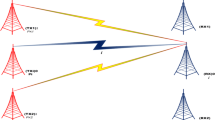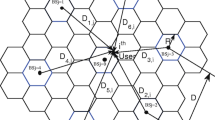Abstract
Recently, the theory of effective rate has attracted much attention, since it can take the delay aspect into account when performing channel capacity analysis. In this paper, we study the effective throughput performance of the multi-antenna system over the Beaulieu-Xie fading channel. Both the probability density function-based approach and the moment generating function-based approaches are used to derive the closed-form expressions of the effective throughput for the multi-antenna system. The application of the proposed solution for the IRS-assisted indoor wireless system over the Beaulieu-Xie fading channel is also discussed. Interesting insights related to the channel fading parameters and the number of reflecting elements on the system performance are drawn and discussed conclusively. In addition to this, we also derived the simplified high-power and low-power approximation that enables direct interpretation of the system performance concerning system fading parameters. The accuracy of the derived theoretical expressions is validated through Monte-Carlo simulation results. The results presented in this study can be used in designing the communication system for real-time applications in femtocells and high-speed trains.









Similar content being viewed by others

References
Kaur, M., & Yadav, R. K. (2021). Effective capacity analysis over Fisher-Snedecor F fading channels with MRC reception. Wireless Personal Communications, 121, 1693–1705.
Wu, D., & Negi, R. (2003). Effective capacity: A wireless link model for support of quality of service. IEEE Transactions on Wireless Communications, 2(4), 630–643.
Khalek, A., & Dawy, Z. (2012). Energy-efficient cooperative video distribution with statistical QoS provisions over wireless networks. IEEE Transactions on Mobile Computing, 11(7), 1223–1236.
Balasubramanian, A., & Miller, S. (2010). The effective capacity of a time division downlink scheduling system. IEEE Transactions on Communications, 58(1), 73–78.
Agarwal, S., De, S., Kumar, S., & Gupta, H. (2015). QoS-aware downlink cooperation for cell-edge and handoff users. IEEE Transactions on Vehicular Technology, 64(6), 2512–2527.
Qiao, D., Gursoy, M., & Velipasalar, S. (2013). Effective capacity of two hop wireless communication systems. IEEE Transactions on Information Theory, 59(2), 873–885.
Chauhan, P. S., Kumar, S. K., Upadhayay, V. K., & Soni, S. K. (2021). Unified approach to effective capacity for generalised fading channels. Physical Communication, 45, 101278.
Benkhelifa, F., Rezki, Z., Alouini, M. S., (2013) Effective capacity of nakagami-m fading channels with full channel state information in the low power regime. In IEEE 24th Annual Int Symp Personal, Indoor, and Mobile Radio Commun (PIMRC), 2013, pp. 1883–1887.
Yadav, P., Kumar, S., Kumar, R., (2021) Analysis of EC over Gamma shadowed α–η–μ fading channel. In IOP Conference series: Material Science & Engineering, Nirjuli, India, p. 012010.
Yadav,P., Kumar, S., Kumar, R. (2020) Effective capacity analysis over α–κ–μ/Gamma composite fading channel. In IEEE Internatational Conference on Advances in Computing,Communication Control and Networking (ICACCCN), Greater Noida, India, pp. 587–592.
Yadav, P., Kumar, S., & Kumar, R. (2020). Effective capacity analysis over generalized lognormal shadowed composite fading channels. Internet Technology Letters, 3(5), e171.
Yoo, S. K., Cotton, S., Sofotasios, P., Muhaidat, S., & Karagiannidis, G. (2020). Effective capacity analysis over generalized composite fading channels. IEEE Access, 8, 123756–123764.
Singh,R., & Rawat, M. (2019) On the performance analysis of effective capacity of double shadowed κ – μ fading channels. In IEEE Region 10 Conference (TENCON), Kochi, India, pp. 806–810.
You, M., Sun, H., Jiang, J., & Zhang, J. (2016). Effective rate analysis in weibull fading channels. IEEE Wireless Communication Letters, 5(4), 340–343.
Matthaiou, M., Alexandropoulos, G. C., Ngo, H. Q., & Larsson, E. G. (2012). Analytic framework for the effective rate of MISO fading channels. IEEE Transactions on Communications, 60(6), 1741–1751.
Zhang, J., Dai, L., Wang,Z., Ng, D., Gerstacke, W. (2015) Effective rate analysis of MISO systems over α-μ fading channels. In Proceeding Global Communications Conference (GLOBECOM), San Diego, CA, 2015, pp. 1–6.
Yilmaz, F., & Alouini, M. (2012). A unified MGF-based capacity analysis of diversity combiners over generalized fading channels. IEEE Transactions on Communications, 60(3), 862–875.
Larsson, E. G., Edfors, O., Tufvesson, F., & Marzetta, T. L. (2014). Massive MIMO for next generation wireless systems. IEEE Communications Magazine, 52(2), 186–195.
Wu, Q., & Zhang, R. (2019). Towards smart and reconfigurable environment: Intelligent reflecting surface aided wireless network. IEEE Communications Magazine, 58(1), 106–112.
Hou, T., et al. (2020). Reconfigurable intelligent surface aided NOMA networks. IEEE Journal on Selected Areas in Communications, 38(11), 2575–2588.
Pan, C., et al. (2020). Intelligent reflecting surface aided MIMO broadcasting for simultaneous wireless information and power transfer. IEEE Journal on Selected Areas in Communications, 38(8), 1719–1734.
Yang, L., et al. (2020). Secrecy performance analysis of RIS-aided wireless communication systems. IEEE Transactions on Vehicular Technology, 69(10), 12296–12300.
Yang, L., Guo, W., & Ansari, I. S. (2020). Mixed dual-hop FSO-RF communication systems through reconfigurable intelligent surface. IEEE Communications Letters, 24(7), 1558–1562.
Li, S., Duo, B., Yuan, X., Liang, Y. C., & Di Renzo, M. (2020). Reconfigurable intelligent surface assisted UAV communication: Joint trajectory design and passive beamforming. IEEE Wireless Communications Letters, 9(5), 716–720.
Odeyemi, K. O., Owolawi, P. A., & Olakanmi, O. O. (2020). Reconfigurable intelligent surface assisted mobile network with randomly moving user over fisher-snedecor fading channel. Physical Communication, 43, 101186.
Nagarajan, D., & Balakrisnan, R. (2021). Error probability and throughput analysis of IRS-assisted wireless system over generalized κ–μ fading channels. Wireless Personal Communications. https://doi.org/10.1007/s11277-021-08740-5 [Online].
Kaur, M., & Yadav, R. K. (2020). Performance analysis of Beaulieu-Xie fading channel. Transactions on Emerging Telecommunications Technologies, 31, e3949.
Beaulieu, N. C., & Jiandong, X. (2015). A novel fading model for channels with multiple dominant specular components. IEEE Wireless Communications Letters, 4(1), 54–57.
Chauhan, P. S., Kumar, S., & Soni, S. K. (2020). On the physical layer security over Beaulieu-Xie fading channel. AEU—International Journal of Electronics and Communications, 113, 152940.
Gradshteyn, I. S., & Ryzhik, I. M. (2007). Table of integrals, series, and products (7th ed.). Academic Press.
Brychkov, Y. A., Marichev, O. I., & Prudnikov, A. P. (1990). Integrals and series: More special functions (3rd ed.). Gordon & Breach Sci. Publ.
Wolfram. (2020) Wolfram function site. [Online]. http://functions.wolfram.com/PDF/MeijerG.pdf
Kang, M., & Alouini, M. S. (2006). Capacity of MIMO Rician channels. IEEE Transactions on Wireless Communications, 5(1), 112–122.
Wolfram. (2020) Wolfram function site. [Online]. http://functions.wolfram.com
You, M., Sun, H., Jiang, J., & Zhang, J. (2017). Unified framework for the effective rate analysis of wireless communication systems over MISO fading channels. IEEE Transactions on Communications, 65(4), 1775–1785.
Funding
No funding was received for this work.
Author information
Authors and Affiliations
Contributions
All the authors have equally contributed in this manuscript.
Corresponding author
Ethics declarations
Conflicts of interest
Authors declare that there is no conflict of interest.
Additional information
Publisher's Note
Springer Nature remains neutral with regard to jurisdictional claims in published maps and institutional affiliations.
Appendix
Appendix
The error in (12) by truncating the series by D number of terms can be given by
Putting g = d−D in the above equation and rearranging we get
Since \(U\left( {A;A - mL + 1 - D - g;\frac{\eta L}{\rho }} \right)\) is a monotonically decreasing function with respect to g. Therefore, \(E_{D}\) can be upper bounded as
Applying Eq. (39) of [15] in the above equation, the closed-form expression of the upper bound of the truncation error can be obtained as Eq. (13)
Rights and permissions
About this article
Cite this article
Kaur, M., Yadav, R.K. EC Analysis of Multi-Antenna System over 5G and Beyond Networks and its Application to IRS-Assisted Wireless Systems. Wireless Pers Commun 124, 1861–1881 (2022). https://doi.org/10.1007/s11277-021-09434-8
Accepted:
Published:
Issue Date:
DOI: https://doi.org/10.1007/s11277-021-09434-8



